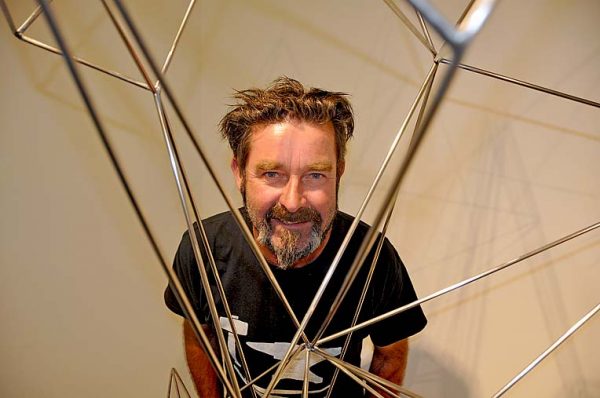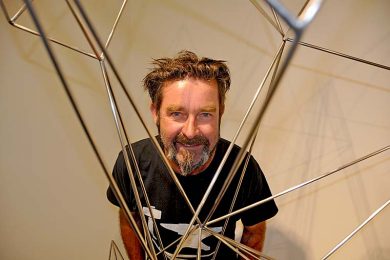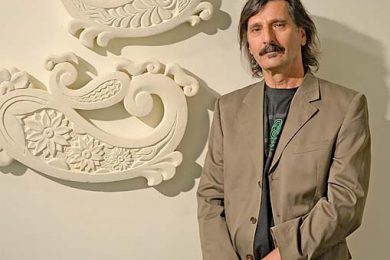
CARVE, Cut, Polish – now on show at the Riddoch Art Gallery – brings together three superbly talented Limestone Coast sculptors with vastly different styles and influences.
Featuring abstract and figurative forms in materials such as limestone, metal and wood, the exhibition celebrates the diversity of sculpture and the practices of Mark de Nys, Ivo Tadic and Kamunde Sadiki.
The Border Watch caught up with the artists ahead of the exhibition’s formal opening tomorrow night.
Born in Mount Gambier, Mark de Nys has a background in engineering and design which informs his work.
His constructive sculpture, which uses ready-found objects and references Dada, is inspired by the state of the world and the human condition.
“This one was created post-9/11,” he said, pointing out one of his works.
“It is of course open to interpretation, but for me the concept was the connections of conspiracy theories – how everything is interconnected – and it sort of resembles a wrecked plane as well.
“I am sometimes influenced by world issues – I try not to be too political, but that was such a big event that rocked the world.
“I was at home when it happened, I was not in a good head space at the time and I could not sleep so I turned on the TV at 4am.
“I thought, ‘wow, this is a cool movie’ and then it dawned on me that it was not a movie and I realised there were a lot worse things going on in the world than what was going on in my world – it put things in perspective.”
He met Bosnian-born Ivo Tadic when he commissioned some of his early work “about 20 years ago”.

“I have known Ivo for years, he said to me recently ‘you know you were one of the first people to commission my work when I came to Mount Gambier’.
“I just admire what he does – his work is beautiful, as is Sadiki’s.
“Their work is subtractive and I’m adding stuff together so we did not know how it would work in the same space, but I think the exhibition provides a good overview of how versatile sculpture is.”
Mr Tadic said he hoped the exhibition would inspire people to buy and display local art.
“I have followed Mark’s work ever since he commissioned my art for his home and we regularly catch up at social events,” Tadic said.
“I hope we can make limestone art part of our identity – so when people walk into businesses in this region they expect to see a limestone sculpture.
“The work lends itself to being displayed in that way.
“Limestone sculpture has only taken off in the last 15 years or so here and it’s such a unique point of interest for the region.
“We have the raw material in abundance and we are known as the Limestone Coast – it would be fantastic to have politicians and business owners promote that by having the sculptures prominently displayed.”
He said his work explored the “big picture” of creation.
“Essentially it’s about the idea of time and space – before the big bang they did not exist or they were in a different form to the way we experience them now in our three dimensional universe,” he said.
“I try to keep my work really tight within that concept and I hope to engage people to think about those things when they look at the work.”
Born in war-torn Congo, Kamunde Sadiki arrived in Australia in 2015 after spending 13 years in a refugee camp in Zambia.
He was introduced to Tadic by fellow artist Kelvin Smibert.
“Kelvin wanted me to show him how to carve limestone – he already had skills in carving, but I gave him some stone and the correct tools,” Mr Tadic said.
“I have mentored him a bit, but he’s pretty independent and he’s talented.
“I encouraged him to express his African aesthetic in limestone.”
Sadiki was in Adelaide due to illness at the time of writing, but said he hoped to attend the exhibition opening tomorrow night.
Sculpting figures with both wood and limestone, his works hold personal, symbolic, religious or political significance of his often harrowing lived experience.
His distinctively African style is blended seamlessly with Australian materials, including river red gum, creating a powerful story of his culture and his new home.
The public is invited to attend the formal opening of the exhibition tomorrow at 6pm.
The exhibition will be on show in the Cathleen Edkins Gallery in the Riddoch Art Gallery until March 11.
Imants Tillers exhibition Philosophy of Doubt will also be officially opened tomorrow night.










